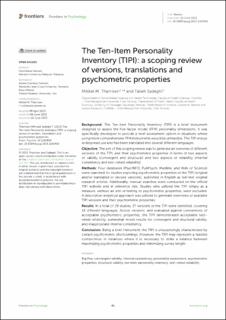| dc.description.abstract | BACKGROUND: The Ten-Item Personality Inventory (TIPI) is a brief instrument designed to assess the five-factor model (FFM) personality dimensions. It was specifically developed to provide a brief assessment option in situations where using more comprehensive FFM instruments would be unfeasible. The TIPI enjoys widespread use and has been translated into several different languages. OBJECTIVE: The aim of this scoping review was to generate an overview of different versions of the TIPI, and their psychometric properties in terms of two aspects of validity (convergent and structural) and two aspects of reliability (internal consistency and test-retest reliability). METHODS: Four databases (PsycINFO, PubPsych, Medline, Web of Science) were searched for studies exploring psychometric properties of the TIPI (original and/or translated or revised versions), published in English as full-text original research articles. Additionally, manual searches were conducted on the official TIPI website and in reference lists. Studies who utilized the TIPI simply as a measure, without an aim of testing its psychometric properties, were excluded. A descriptive-analytical approach was utilized to generate overviews of available TIPI versions and their psychometric properties. RESULTS: In a total of 29 studies, 27 versions of the TIPI were identified, covering 18 different languages. Across versions, and evaluated against conventions of acceptable psychometric properties, the TIPI demonstrated acceptable test-retest reliability, somewhat mixed results for convergent and structural validity, and inappropriate internal consistency. CONCLUSIONS: Being a brief instrument, the TIPI is unsurprisingly characterized by certain psychometric shortcomings. However, the TIPI may represent a feasible compromise in instances where it is necessary to strike a balance between maximizing psychometric properties and minimizing survey length. | en_US |

